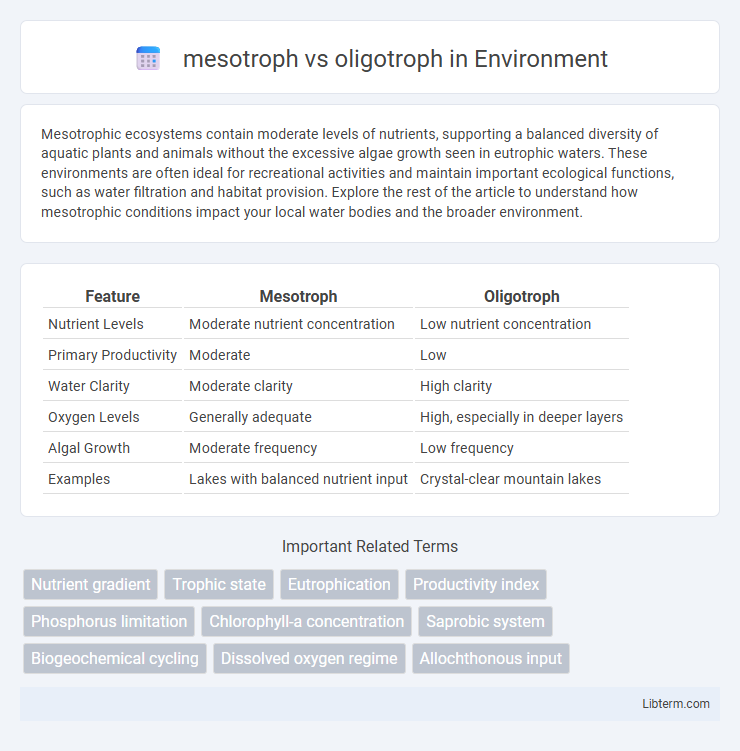Mesotrophic ecosystems contain moderate levels of nutrients, supporting a balanced diversity of aquatic plants and animals without the excessive algae growth seen in eutrophic waters. These environments are often ideal for recreational activities and maintain important ecological functions, such as water filtration and habitat provision. Explore the rest of the article to understand how mesotrophic conditions impact your local water bodies and the broader environment.
Table of Comparison
| Feature | Mesotroph | Oligotroph |
|---|---|---|
| Nutrient Levels | Moderate nutrient concentration | Low nutrient concentration |
| Primary Productivity | Moderate | Low |
| Water Clarity | Moderate clarity | High clarity |
| Oxygen Levels | Generally adequate | High, especially in deeper layers |
| Algal Growth | Moderate frequency | Low frequency |
| Examples | Lakes with balanced nutrient input | Crystal-clear mountain lakes |
Introduction to Mesotrophs and Oligotrophs
Mesotrophs are organisms that thrive in environments with moderate nutrient levels, balancing between nutrient-rich and nutrient-poor conditions. Oligotrophs, in contrast, adapt to nutrient-poor environments by efficiently utilizing scarce resources and often exhibiting slower growth rates. The distinction between mesotrophs and oligotrophs highlights their ecological roles, with mesotrophs dominating habitats with intermediate nutrient availability and oligotrophs prevailing in nutrient-limited ecosystems.
Defining Mesotrophic and Oligotrophic Environments
Mesotrophic environments contain moderate nutrient levels, supporting balanced aquatic ecosystems with diverse plant and animal life, while oligotrophic environments are characterized by low nutrient concentrations, resulting in clear, oxygen-rich waters with limited biological productivity. Mesotrophic lakes typically exhibit intermediate productivity between nutrient-poor oligotrophic lakes and nutrient-rich eutrophic lakes, influencing species composition and water quality. Understanding the nutrient gradients and biological responses in these environments is crucial for effective ecosystem management and conservation strategies.
Key Characteristics of Mesotrophic Ecosystems
Mesotrophic ecosystems exhibit moderate nutrient levels, supporting balanced aquatic plant growth and diverse biological communities. These ecosystems typically have intermediate productivity, clear water with moderate algal populations, and sufficient oxygen levels to sustain fish and invertebrate species. Unlike oligotrophic systems, mesotrophic waters display higher nutrient concentrations, leading to increased biological activity without the risk of eutrophication.
Features of Oligotrophic Ecosystems
Oligotrophic ecosystems are characterized by low nutrient concentrations, particularly nitrogen and phosphorus, leading to limited primary productivity and clear water with high oxygen levels. These ecosystems typically feature deep waters with low organic matter and support specialized organisms adapted to nutrient-poor conditions. Compared to mesotrophic systems, oligotrophic environments have minimal algal blooms and greater biodiversity among species adapted to oligotrophy.
Differences in Nutrient Levels
Mesotroph environments contain moderate nutrient levels, supporting balanced biological productivity, while oligotroph habitats have low nutrient concentrations, leading to limited biomass and reduced primary productivity. Mesotrophic waters often experience seasonal algal blooms due to higher phosphorus and nitrogen availability, whereas oligotrophic waters maintain clear conditions with minimal nutrient enrichment. The contrasting nutrient levels directly impact ecosystem complexity and species diversity in these aquatic systems.
Microbial and Biological Diversity Comparison
Mesotrophic environments support a higher microbial and biological diversity than oligotrophic systems due to moderate nutrient levels that foster diverse microbial communities, including bacteria, algae, and protozoa. Oligotrophic waters exhibit low nutrient concentrations, resulting in limited microbial populations dominated by specialized, slow-growing species adapted to nutrient scarcity. The balance of nutrient availability in mesotrophic habitats promotes complex food webs and greater ecosystem productivity compared to the nutrient-poor, less biologically diverse oligotrophic environments.
Ecological Impacts on Water Bodies
Mesotrophic water bodies, characterized by moderate nutrient levels and productivity, support diverse aquatic ecosystems but can shift toward eutrophication if nutrient inputs increase, leading to algal blooms and oxygen depletion. Oligotrophic lakes contain low nutrient concentrations, resulting in clear waters with limited productivity and higher oxygen levels, which often sustain sensitive species like trout and certain plankton. The ecological balance in both systems is crucial for maintaining biodiversity, water quality, and ecosystem services such as fisheries and recreation.
Examples of Mesotrophic and Oligotrophic Habitats
Mesotrophic habitats, such as Lake Michigan and the Chesapeake Bay, exhibit moderate nutrient levels that support diverse aquatic life including fish species like bass and perch. Oligotrophic habitats like Crater Lake and parts of the Canadian Shield have low nutrient concentrations, resulting in clear waters and limited algal growth, favoring organisms adapted to nutrient-poor conditions. These contrasting nutrient levels dictate the biodiversity and productivity characteristic of each ecosystem type.
Monitoring and Management Strategies
Monitoring mesotrophic and oligotrophic water bodies requires regular assessment of nutrient levels, particularly phosphorus and nitrogen concentrations, to prevent eutrophication and maintain ecological balance. Management strategies for mesotrophic lakes often include controlled nutrient input reductions and aeration techniques to support moderate productivity without triggering algal blooms. In contrast, oligotrophic waters demand protection from increased nutrient loading and sediment disturbance through strict land-use controls and buffer zone establishment to preserve their low-nutrient, high-oxygen conditions.
Future Research Directions and Environmental Implications
Future research on mesotrophs and oligotrophs should prioritize understanding their adaptive mechanisms in response to climate change and nutrient cycling alterations in aquatic and terrestrial ecosystems. Investigating the genomic and metabolic pathways that enable mesotrophs to thrive in moderate nutrient environments versus oligotrophs' efficiency in nutrient-poor conditions can inform biotechnological applications for environmental sustainability. Enhanced knowledge of these microbial functional groups will improve ecosystem management strategies, particularly in mitigating eutrophication and preserving biodiversity in nutrient-limited habitats.
mesotroph Infographic

 libterm.com
libterm.com